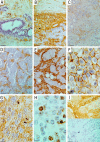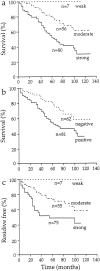Hyaluronan in peritumoral stroma and malignant cells associates with breast cancer spreading and predicts survival
- PMID: 10666382
- PMCID: PMC1850058
- DOI: 10.1016/S0002-9440(10)64757-8
Hyaluronan in peritumoral stroma and malignant cells associates with breast cancer spreading and predicts survival
Abstract
Hyaluronan (HA) is an extracellular matrix polysaccharide that promotes cell migration through its cell surface receptors and by effecting changes in the physical environment. HA expression is frequently increased in malignant tumors, whereas its association with the invasive potential and patient outcome in breast cancer has not been reported. The localization and signal intensity of HA was analyzed in 143 paraffin-embedded tumor samples of human breast carcinoma using a biotinylated HA-specific probe. In the immediate peritumoral stroma, HA signal was moderately or strongly increased in 39% and 56% of the cases, respectively. Normal ductal epithelium showed no HA, whereas in 57% of the tumors at least some of the carcinoma cells were HA positive. The intensity of the stromal HA signal and the presence of cell-associated HA were both significantly related to poor differentiation of the tumors, axillary lymph node positivity, and short overall survival of the patients. In Cox's multivariate analysis, both the intensity of stromal HA signal alone and that combined with the HA positivity in tumor cells were independent prognostic factors for overall survival. These results suggest that HA is directly involved in the spreading of breast cancer and may offer a potential target for new therapies.
Figures


Similar articles
-
Increased hyaluronan content and stromal cell CD44 associate with HER2 positivity and poor prognosis in human breast cancer.Int J Cancer. 2013 Feb 1;132(3):531-9. doi: 10.1002/ijc.27707. Epub 2012 Jul 20. Int J Cancer. 2013. PMID: 22753277
-
Hyaluronan expression in differentiated thyroid carcinoma.J Pathol. 2002 Feb;196(2):180-5. doi: 10.1002/path.1032. J Pathol. 2002. PMID: 11793369
-
Breast cancer stromal myxoid changes are associated with tumor invasion and metastasis: a central role for hyaluronan.Mod Pathol. 2003 Feb;16(2):99-107. doi: 10.1097/01.MP.0000051582.75890.2D. Mod Pathol. 2003. PMID: 12591961
-
Hyaluronan in human tumors: pathobiological and prognostic messages from cell-associated and stromal hyaluronan.Semin Cancer Biol. 2008 Aug;18(4):288-95. doi: 10.1016/j.semcancer.2008.03.005. Epub 2008 Mar 26. Semin Cancer Biol. 2008. PMID: 18468453 Review.
-
Carcinoma Cell Hyaluronan as a "Portable" Cancerized Prometastatic Microenvironment.Cancer Res. 2016 May 1;76(9):2507-12. doi: 10.1158/0008-5472.CAN-15-3114. Epub 2016 Apr 20. Cancer Res. 2016. PMID: 27197262 Free PMC article. Review.
Cited by
-
The interaction between LYVE-1 with hyaluronan on the cell surface may play a role in the diversity of adhesion to cancer cells.PLoS One. 2013 May 22;8(5):e63463. doi: 10.1371/journal.pone.0063463. Print 2013. PLoS One. 2013. PMID: 23717428 Free PMC article.
-
C-Phycocyanin-derived Phycocyanobilin as a Potential Nutraceutical Approach for Major Neurodegenerative Disorders and COVID-19- induced Damage to the Nervous System.Curr Neuropharmacol. 2021;19(12):2250-2275. doi: 10.2174/1570159X19666210408123807. Curr Neuropharmacol. 2021. PMID: 33829974 Free PMC article.
-
Hyaluronan synthase HAS2 promotes tumor progression in bone by stimulating the interaction of breast cancer stem-like cells with macrophages and stromal cells.Cancer Res. 2012 Jan 15;72(2):537-47. doi: 10.1158/0008-5472.CAN-11-1678. Epub 2011 Nov 23. Cancer Res. 2012. PMID: 22113945 Free PMC article.
-
Desmoplasia in Primary Tumors and Metastatic Lesions of Pancreatic Cancer.Clin Cancer Res. 2015 Aug 1;21(15):3561-8. doi: 10.1158/1078-0432.CCR-14-1051. Epub 2015 Feb 18. Clin Cancer Res. 2015. PMID: 25695692 Free PMC article.
-
Proteoglycans: pericellular and cell surface multireceptors that integrate external stimuli in the mammary gland.J Mammary Gland Biol Neoplasia. 2001 Jul;6(3):253-73. doi: 10.1023/a:1011367423085. J Mammary Gland Biol Neoplasia. 2001. PMID: 11547896 Review.
References
-
- Toole B: Glycosaminoglycans in morphogenesis. Hay ED eds. Cell Biology of the Extracellular Matrix. 1981, :pp 259-294 Plenum Press, New York
-
- Laurent T, Fraser J: Hyaluronan. FASEB J 1992, 6:2397-2404 - PubMed
-
- Tammi R, Ripellino JA, Margolis RU, Tammi M: Localization of epidermal hyaluronic acid using the hyaluronate binding region of cartilage proteoglycan as a specific probe. J Invest Dermatol 1988, 90:412-414 - PubMed
-
- Knudson W, Biswas C, Li X-Q, Nemec R, Toole B: The role and regulation of tumour-associated hyaluronan. The Biology of Hyaluronan. Edited by D Evered, J Whelan. Ciba Found Symp 1989, 143:150–169 - PubMed
Publication types
MeSH terms
Substances
LinkOut - more resources
Full Text Sources
Other Literature Sources
Medical

